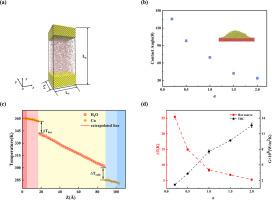Effect of surface wettability on thermal conductance of Cu-water interface: A molecular dynamics study
IF 4.3
Q2 CHEMISTRY, PHYSICAL
引用次数: 0
Abstract
As micro and nano-scale devices move toward higher integration and miniaturization, efficient thermal management has become increasingly vital. Among the key factors influencing heat dissipation at the nano-scale is the regulation of solid-liquid interfaces. However, the mechanism by which surface wettability alters the interfacial water structure—and consequently affects interfacial thermal transport—remains insufficiently understood. To address this gap, molecular dynamics (MD) simulations were employed to investigate interfacial thermal transport behaviors in Cu-water nanochannels, with a specific focus on the role of wettability in modulating the dynamic characteristics of interfacial water molecules. The results demonstrate that increased wettability significantly enhances thermal boundary conductance (TBC), primarily by promoting the formation of denser and more stable H-bond networks at the interface. This study highlights the critical role of interfacial H-bonding in regulating thermal transport and provides valuable insights for optimizing thermal efficiency in nanofluidic and nanoelectronic systems.

表面润湿性对铜-水界面热导率的影响:分子动力学研究
随着微纳米级器件向着更高集成度和小型化的方向发展,高效的热管理变得越来越重要。影响纳米尺度散热的关键因素之一是固液界面的调节。然而,表面润湿性改变界面水结构,从而影响界面热传递的机制仍然没有得到充分的了解。为了解决这一空白,采用分子动力学(MD)模拟来研究cu -水纳米通道中的界面热传输行为,特别关注润湿性在调节界面水分子动态特性中的作用。结果表明,润湿性的增加显著提高了热边界导率(TBC),主要是通过促进界面上形成更致密、更稳定的氢键网络来实现的。该研究强调了界面氢键在调节热传递中的关键作用,并为优化纳米流体和纳米电子系统的热效率提供了有价值的见解。
本文章由计算机程序翻译,如有差异,请以英文原文为准。
求助全文
约1分钟内获得全文
求助全文
来源期刊

Chemical Physics Impact
Materials Science-Materials Science (miscellaneous)
CiteScore
2.60
自引率
0.00%
发文量
65
审稿时长
46 days
 求助内容:
求助内容: 应助结果提醒方式:
应助结果提醒方式:


